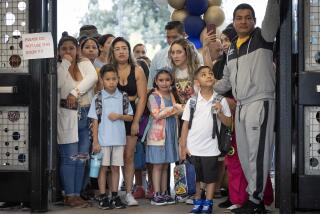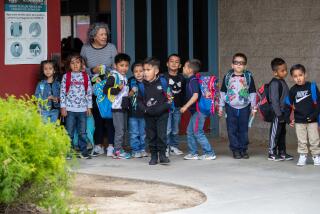‘90s FAMILY : Ready and Able : Self-reliance is harder for kids now than generations past. The trick, experts say, is not to push them too fast--or hold them back.
- Share via
“There’s no use kidding myself,” says the “Peanuts” cartoon character Linus clutching his much-famed transitional object. “Without this blanket I’d crack like a piece of old bamboo.”
Linus is not being a baby. He’s learned to comfort himself instead of always calling for Mom or Dad.
The cartoon is taped to Helen Reid’s desk as a reminder of one of the essential steps young children go through on their road to self-reliance. According to Reid, clinical coordinator for the Early Childhood Development Center at Cedars-Sinai Medical Center, such attachments are healthy in children and one of many developmental milestones. Others include sleeping through the night, potty training, resolving conflict, getting along in groups, and doing homework and chores.
“A person who is not self-reliant relies on external forces, rather than internal ones, to be productive,” says Dr. Rudolf L. Brutaco, a specialist in behavioral and developmental pediatrics. “Often well-intentioned parents do so much for their children that by doing so they actually undermine the child’s growth and development.”
Brutaco, medical director of the Life Stages Center for Developmental Medicine in Irvine and Covina, says that becoming self-reliant is harder today than in generations past. “Our children grow up in a very passive way; a lot is done for them,” says Brutaco, a father of four. “Then they’re thrust into the world and expected to perform.”
Twenty years ago, most kids were responsible for their transportation to school, he points out. They walked, rode their bikes, got themselves to the bus stop or arranged for a ride. Today, concerned about safety, most parents arrange their children’s transportation. Television also deters self-reliance. While it entertains, kids have little responsibility for entertaining themselves.
So how do you teach self-reliance in a world filled with instant entertainment and free rides? The trick, says Reid, who defines a self-reliant child as one who believes in himself, is not to push a child too fast or hold him back. “If you push a child too fast, you will overwhelm him and he will fail. On the contrary, if you overprotect a child, he’ll never learn the consequences of his actions.”
After working with infants and children through age 5 for 34 years, Reid has observed the following characteristics in self-reliant infants and children: Infants and toddlers can put themselves to sleep and comfort themselves. Toddlers and preschoolers can separate from their moms easily. Self-reliant kids are not afraid to try new things or to make a mistake. They find joy in achievement. They greet the world with a smile and walk into a new situation with confidence.
Experts agree that teaching a child self-reliance begins in infancy. “We start talking to parents about self-reliance right away,” says Dr. Howard Reinstein, an Encino-based pediatrician. “Getting kids to sleep through the night, teaching them that they can soothe themselves by sucking their thumb or a pacifier, and attaching to a transitional object like a blanket or soft stuffed animal are all ways to begin teaching self-reliance.”
Babies work out other problems through experimenting, and here again, parents do a disservice by being too protective. “If a child is kept in a playpen, he might be safe, but he can’t explore his environment. You need to let him discover the results of his actions, so if he makes a mistake he can redirect actions and find new solutions,” Brutaco says.
Once into toddlerhood, children go through a critical period of separation. “Between 18 and 24 months, they want to do everything themselves,” Reid says. “Although they do aggravating things and say ‘no’ to everything, the desire needs to be respected. This is the child’s way of establishing himself as a separate person.” To help a child through this struggle, teach and encourage him to do things he does have control over, like dressing and feeding himself. Let the child make choices you will support.
Reinstein suggests offering “pseudo choices” at first: “Would you like to wear this or this?” This way, the child feels he has a choice but doesn’t choose to wear a bathing suit on a winter day. As children get older, they can get involved in other family decisions: what to have for dinner, what to do for fun. Giving children a say helps them feel competent and in control.
Another area in which young children gain control is toilet training. But it’s also where parents make some of their biggest mistakes. “This is the kid’s job, not the parents’,” Reinstein says. “When kids decide they want to do this, the whole process takes about four days. Parents tend to get too involved and thereby undermine the natural development of self-reliance.”
This is a perfect example of how fostering self-reliance, which is internal, differs from discipline, which is external, Brutaco says. “It’s better for a child to learn that he prefers wearing dry pants because wet pants feel uncomfortable, than for a child to think he will get in trouble for having wet pants, which comes through discipline. Self-reliance comes from recognizing and interpreting the repercussions of one’s actions.”
As toddlers enter preschool and begin interacting more with other children, the primary goal becomes teaching self-control and conflict resolution. First try to let the kids work out their own battles. If one becomes aggressive, then intervene but don’t solve the problem. Ask the children how to best solve the problem and to talk out the hurts.
Kids can get involved with solving conflicts at home, too, Reinstein says. “If you and your 4-year-old are having a rough time, say, ‘You and I aren’t having a good morning together. What could we do to make it better?’ Sometimes they come up with some very good responses, like don’t talk on the phone so much.”
As children enter grade school, parents start seeing their efforts to teach self-reliance pay off when their kids do their homework without prodding and household chores without nagging. But usually this doesn’t happen without some reinforcement, or at least a few refresher courses.
The hardest lesson here for parents is to back off. “Homework is for the kids, not parents,” Reinstein says. “Don’t be afraid to let them fail. If they don’t study for their math test, let them suffer the consequences.”
One parent who is teaching self-reliance to her teen-agers is Beata Lundeen of Thousand Oaks. When her 14-year-old daughter, Meredith, was slacking off on her science project, Lundeen searched for a creative way to instill consequences while still letting the impetus for completion be her daughter’s.
“I asked her what the most important thing happening to her between now and the end of the school year was. She said the promotion dance. I said, ‘Fine. If you don’t get a B on your science project, you’re not going.’ ”
Meredith stayed up till 2:30 a.m. for four days in a row getting her report and presentation ready. “When she called me at work to tell me she got an A, we both screamed. I think I learned more from her project than she did,” Lundeen says.
Lundeen also tries to teach Meredith and her younger daughter, Allyson, 12, the virtue of doing work on time. Both her daughters have a list of chores. If they don’t do one of their chores one day, they do an extra one, along with the one they didn’t do, the following day. “I’m trying to teach them that if they don’t get something done when they should, the work mounts.”
Brutaco says getting kids to pitch in at home is vital to developing self-reliance. “As early as possible, kids should start contributing to the family. Even toddlers can help put things away.”
In addition to sharing the workload, parents should also share problems with kids. “Talk to your kids about your life’s problems and how you solve them,” Brutaco says. “It’s OK to say we’re a little short on money this month because our income is down a bit and we had this extra expense, so here’s how we’re going to deal with it.”
While most experts agree that the foundation for self-reliance is laid early, parents can always promote the concept, Brutaco says. “I’ve seen kids with high SAT scores and high grades absolutely flounder in college because parents monitored their homework too closely at home. It’s not too late to teach these kids time management, organizational skills and goal setting.”
Reid concurs: “You start teaching kids self-reliance when they’re born, and I’m not sure when you stop.”
More to Read
Sign up for Essential California
The most important California stories and recommendations in your inbox every morning.
You may occasionally receive promotional content from the Los Angeles Times.













